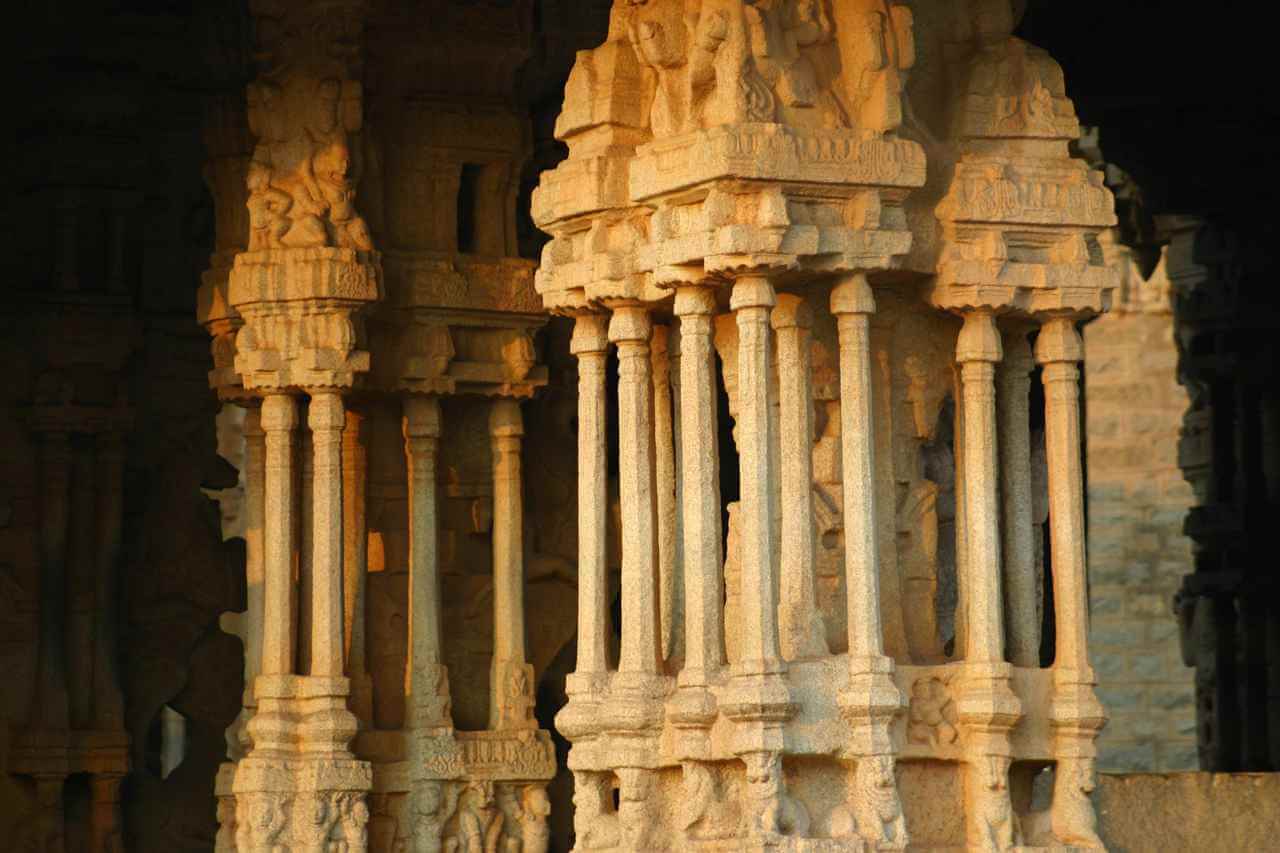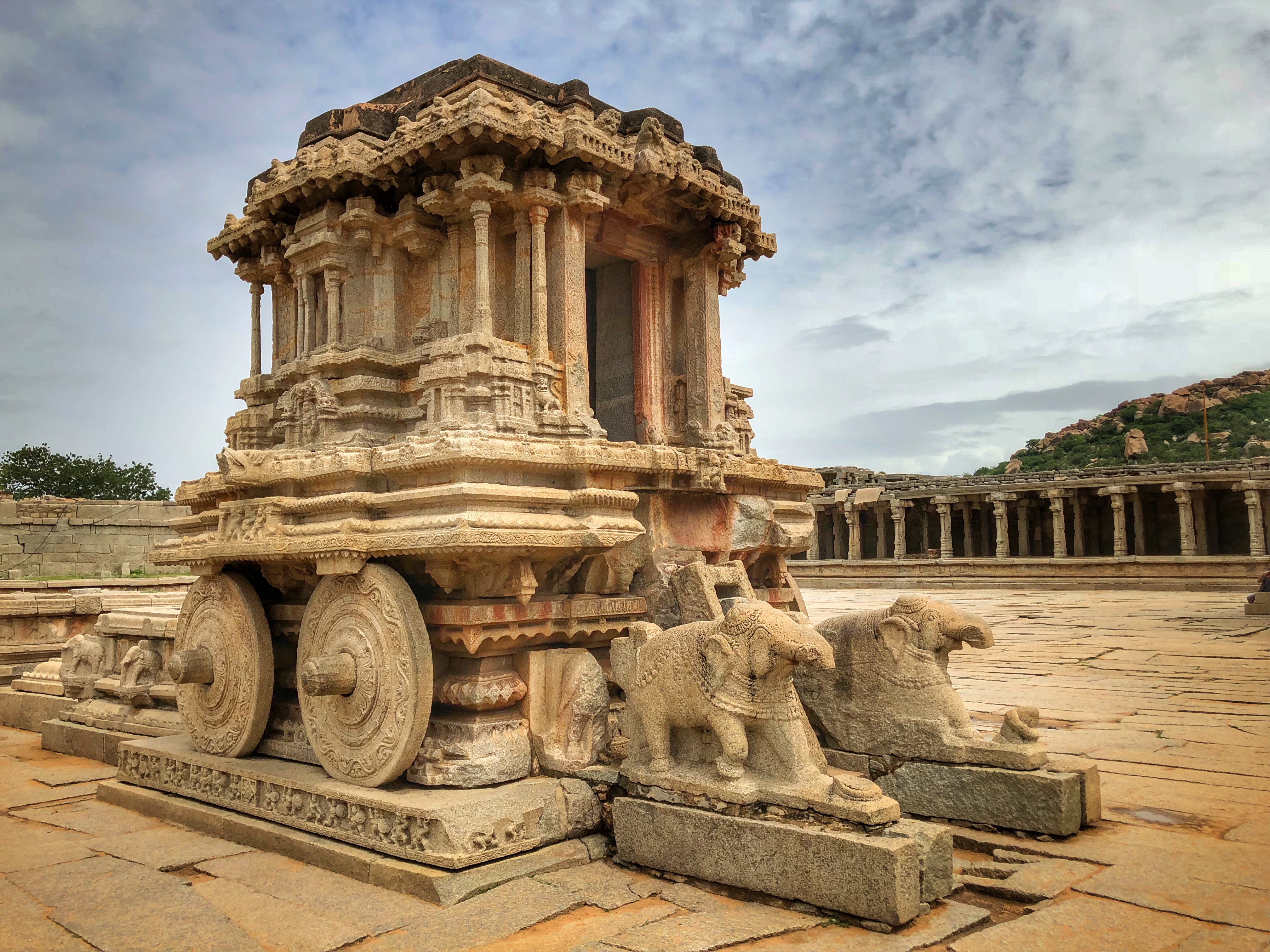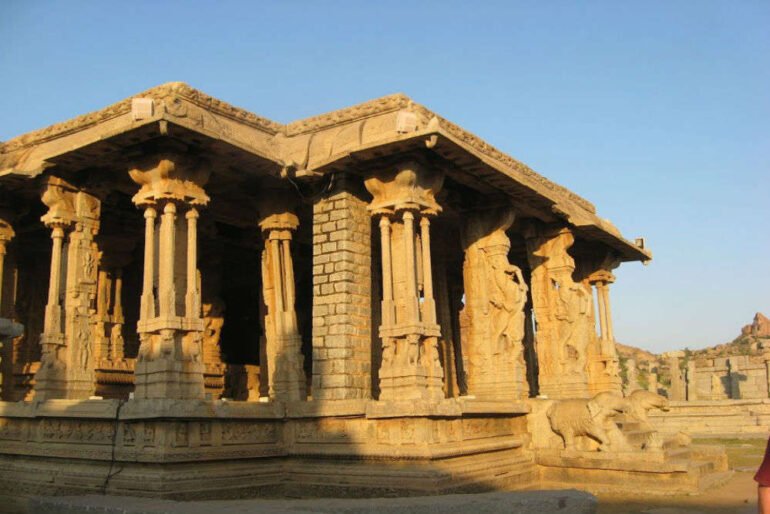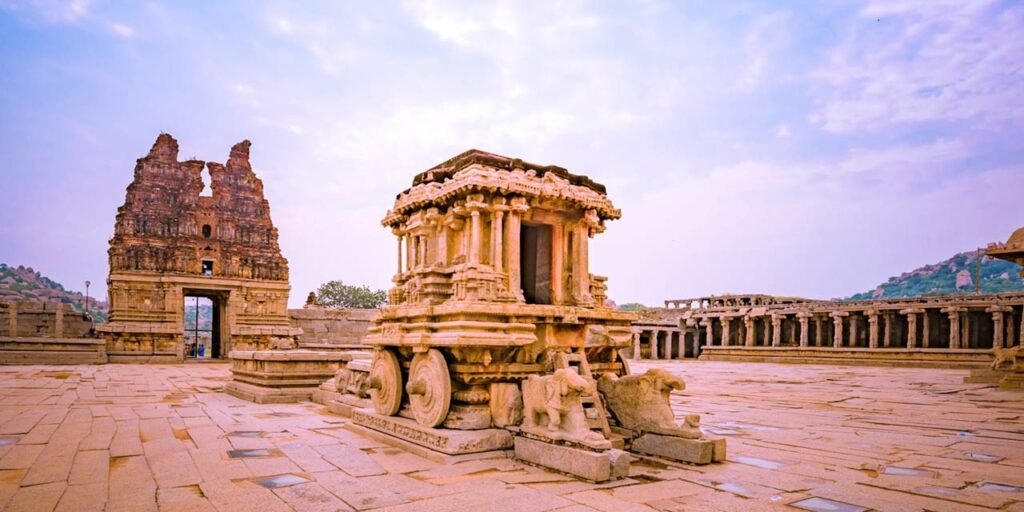What About Vitthala Temple?
Vitthala temple portrays the high watermark of perfection of the Vijayanagara style, and one may well say that there is no other building that could stand in comparison with it in florid magnificence.
As the epicenter of Hampi’s attractions, It is the most extravagant architectural showpiece of Hampi. No amount of words can explain this spectacle. The temple is built in the form of a sprawling campus with compound wall and gateway towers. There are many halls, pavilions, and temples located inside this campus.
History Of The Temple
Vitthala, after whom the temple is known, is a form of Lord Vishnu. This aspect of Vishnu was worshiped in this part of the country as their cult deity by the cattle herders
The temple was originally built in the 15th century AD.
Many successive kings have enhanced the temple campus during their regimes to the present form. You can even see the remains of a township called Vittalapura that existed around this temple complex. The highlight of the Vittala temple is its impressive pillared halls and the stone chariot.
Magnificent Architecture Of The Temple
The halls are carved with an overwhelming array of sculptures on the giant granite pillars. The stone chariot located inside the campus is almost an iconic structure of Hampi. An image of Garuda (the eagle god) was originally enshrined within its sanctum. Garuda, according to Hindu mythology, is the vehicle of Lord Vishnu. Thus the Garuda shrine facing the temple’s sanctum is symbolic.
It may appear (and sometimes even referred to) as a monolithic structure. In reality, this stone shrine was built with many giant granite blocks. The joints are smartly hidden in the carvings and other decorative features that adorn the Stone Chariot. The chariot is built on a rectangular platform of feet or so high. All around this base platform is carved with mythical battle scenes.
A series of concentric floral motifs decorate the wheels. It appears from the marks on the platform, where the rest of the wheel, the wheels were free to move around the axis.
Probably because it was relatively protected from the natural wearing elements, the undercarriage of the chariot spots one of the best-preserved specimens of this kind of paintings.
It is believed the whole of the Vittala Temple’s sculptures were once beautifully painted in a similar fashion using the minerals as a medium. The balustrades on the east and west porch of this hall are more dramatic with giant lion Yalis fighting the relatively dwarf elephants. The Maha-Mantapa stands on a highly ornate platform.
The Maha-Mantapa contains four open halls within. The south, north, and east ones are still intact. The central-western hall is collapsed, probably due to the arson that followed the fall of the capital. The main highlight of the Maha-Mantapa is its richly carved giant monolithic pillars. The outermost of the pillars is popularly called the musical pillars. These slender and short pilasters carved out of the giant pillars emit musical tones when tapped. Probably these do not belong to any of the standard musical notes, but the musical tone of the vibes earned it’s the name.
The ceilings of the halls too are of interest with the lotus-like carving at the center.

Eye Map To the Temple
One typically accesses the campus through the eastern entrance tower, next to which the ticket counter is located. On entering through this massive tower, the first thing that draws your attention would be a series of compact platforms along the central axis of the campus. At the end of these platforms stands the Stone Chariot. This is, in fact, a shrine built in the form of a temple chariot.

On leaving the Stone Chariot you reach the main hall in front of the Vittala temple.
This hall though partially damaged is still awe-inspiring. Facing the Stone Chariot, a series of steps flanked by elephant balustrades gives access to this elevated open hall called the Maha-Mantapa (the great hall).
The eastern hall which is called the musician’s hall is notable for sculptures of musicians on the pillars. Each of the pillars surrounding this hall is sculptured with musicians, drummers, and dancers.
The southern half is dominated by the rampant mythical creatures called Yalis. The capitals of each of the pillars branches into heavily ornate corbels with terminating with lotus buds.
The northern hall is surrounded by a series of pillars with the Narasimha (the man-lion incarnation of Vishnu) themes. The most notable ones are that of Narasimha slaying Hiranyakashipu on his lap.
Further west is a closed hall with two porches on either side. Further ahead is the sanctum.
The inner sanctum is devoid of any idol. A narrow and unlit passageway encircles the inner sanctum.
The other attractions include the Goddess’s shrine in the northwest, the 100-pillared hall at the southwest, the Kalayna Mantapa (the ceremonial marriage hall) in the southeast and the pillared cloisters all around the enclosure wall.
Some Interesting Myths & Facts
- In front of the chariot, two elephants are positioned as if they are pulling the chariot. In fact, these elephants were brought from elsewhere and positioned here at a later stage.
- Originally two horses were carved in the position of elephants. The tails and the rear legs of the horses can be still seen just behind these elephant sculptures.
- An image of a bull and elephant with a shared head can be seen near the maha mandapa. The left portion is complete as a bull and the right as an elephant. Any local guide would show that to you.

How To Reach?
You can reach the Vitthala temple in two ways. The first is by the road and the second is by a walk along the riverbank from Hampi Bazaar. You can take an auto-rickshaw from the Hampi bus stand to the Vitthala temple. Or catch a local bus first from Hampi bus stand to Kamalapura and then from Kamalapura to Vitthala temple (ask anyone at the Kamalapura bus stand to spot you the right bus)
Things To Know For Tourists
- Due to the seamless outbreak of the pandemic, The tickets have to be booked online; Go to Google, search for Asi.payumoney, Heritage Monument Of India, City: Please select “Hampi”, Monuments: “Group Of Monuments Hampi”, Date, Timings, Proceed, Payment Process.
- The vehicles have to be parked at a distant parking lot, away from the Vitthala temple complex.
- You can either track down the path by either deciding to walk or there are solar driven electric vehicles, which costs you Rs. 10 for a single-way journey and for a person.
- Photography is allowed unless you’re shooting for a movie or a TV series. For that, you should have a permission letter from the authorities.
- The use of tripods is not permitted inside the temple campus.
- The monument opens from 8.30 in the morning to 5.30 in the evening. Try to visit this place soon it opens in the morning. You can practically see & photograph peacefully before the crowd builds up slowly.
- Preserve the pdf of this ticket. You can use the ticket for the same day to enter the Zenana Enclosure area in the Royal Centre and Lotus Mahal.


